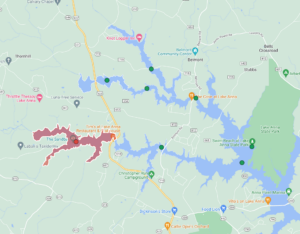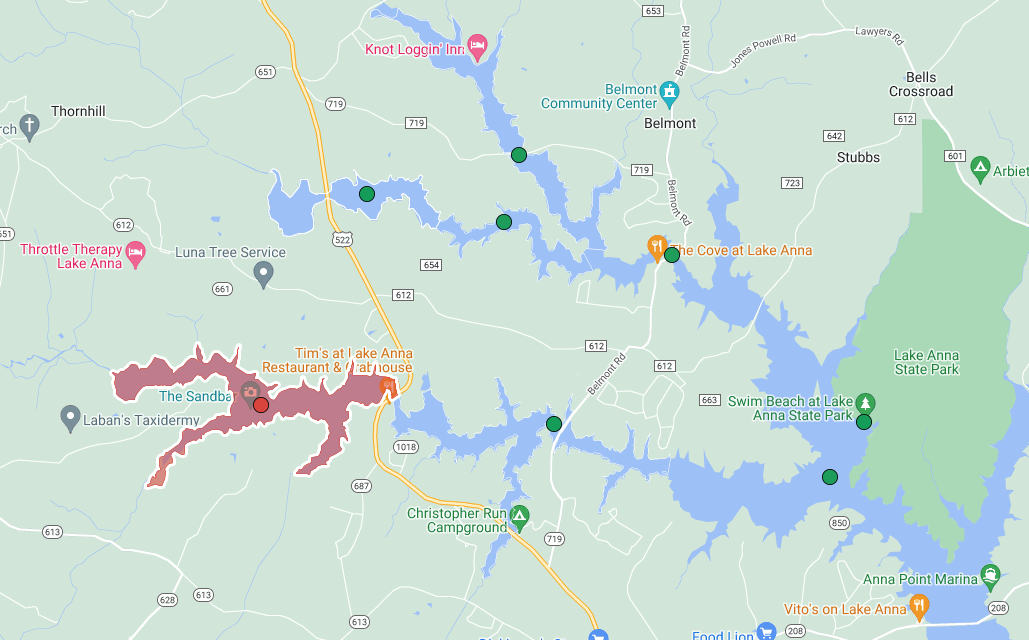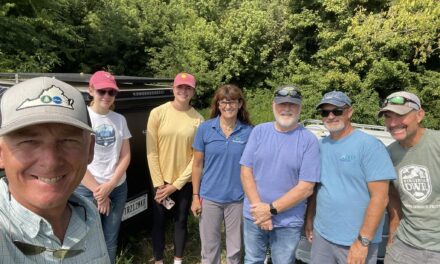
Harmful algal bloom warnings were back at Lake Anna just ahead of the July 4th holiday.
On June 19 the Virginia Department of Health issued an HAB advisory for the Upper Pamunkey branch of the lake in Orange and Spotsylvania counties after testing found high concentrations of cyanobacteria that can be detrimental to human health and harmful to wildlife and pets. The area under the advisory stretches from “the upper inundated waters of Pamunkey Branch to Runnymede subdivision.”
Tests conducted on June 26 found unsafe levels of cyanobacteria at only one of seven test sites. Toxins were identified at several other locations but were at acceptable levels, per VDH.
The next round of monitoring, scheduled for the third week of July, trigged an HAB advisory for the upper portion of the North Anna River down to the Rt. 522 Bridge (August 4) and concluded the Pamunkey advisory could be lifted (August 7).
As with all HAB advisories, the public is advised to avoid direct contact with this specific area of the lake until algae concentrations return to acceptable levels. The advisory warns people and pets to avoid activities that may involve ingesting water like swimming, windsurfing and standup paddle boarding. In humans, toxins produced by cyanobacteria can cause skin rash and gastrointestinal illness including nausea, vomiting and diarrhea.
This is the sixth consecutive year that the blooms have occurred during the peak tourist season at the lake. VDH has issued “no swim” advisories for parts of the lake’s upper end every summer since 2018. Last year, the advisories reached as far south as the Route 208 bridge and, for several weeks, encompassed the main beach at Lake Anna State Park. This year’s advisories came later and have not expanded as far, yet.
The persistence of the blooms has alarmed local and state officials and, last August, prompted the Virginia Department of Environmental Quality to place the lake on its list of impaired waterways. The designation potentially opens the door to increased state action to address the blooms.
Even before DEQ’s designation, members of the Louisa County Board of Supervisors and grassroots activists with the Lake Anna Civic Association and the Lake Anna Advisory Committee had urged state lawmakers to direct resources to the lake to support both short-term tactics to control HAB and long-term mitigation strategies. In a meeting with legislators, Board Chair Duane Adams called the lake “a tremendous economic engine” and warned of the blooms’ impact on the local economy if they drive away tourists.
Those lobbying efforts bore some fruit last year when lawmakers included in the biennial state budget $3.5 million to study HAB in the Shenandoah River and at Lake Anna. DEQ launched its lake-specific HAB study earlier this year with the goal of developing a watershed plan over the next three years aimed at limiting the blooms.
While the exact cause of HAB at Lake Anna is complex, the blooms’ growth is generally attributed to excess nutrients, like phosphorus and nitrogen, in warm, slow-moving water. The first phase of the DEQ study includes extensive data collection to determine exactly what sorts of algal species are present and identification of pollutants contributing to the blooms as well as other causal factors, a representative of the department told supervisors in December. After that, the study will focus on developing predicative models for early detection, identifying management approaches, and working with stakeholders to develop the watershed plan.
Help could also be on the way for more immediate efforts to stymie the blooms’ growth, pending the General Assembly’s approval of a package of amendments to the state budget. A spending bill passed by the House of Delegate earlier this year directs $1 million to the Department of Conservation and Recreation “to support cyanobacteria mitigation and remediation efforts at Lake Anna” while the Senate budget bill calls for $500,000, according to the state budget website.
Beyond state aid, LACA has led local, grassroots efforts to mitigate and remediate the blooms. Through its Kick the HAB fundraising campaign, the organization started a pilot treatment program last summer deploying a product called Lake Guard Oxy at four test sites. The product has been used to combat algae and cyanobacteria in other waterways.
This summer, according to its website, LACA is expanding its program to implement other technologies including ultrasound mitigation capabilities in three test locations and a phosphorous reduction capability at one other location. The goal, LACA says, is “to maintain cyanobacteria levels at or below pre-treatment levels in those four areas for the 2023 recreational season.”
So far, the organization has raised more than $23,000 of its $50,000 goal to fund the program. See related story on page 20.
























